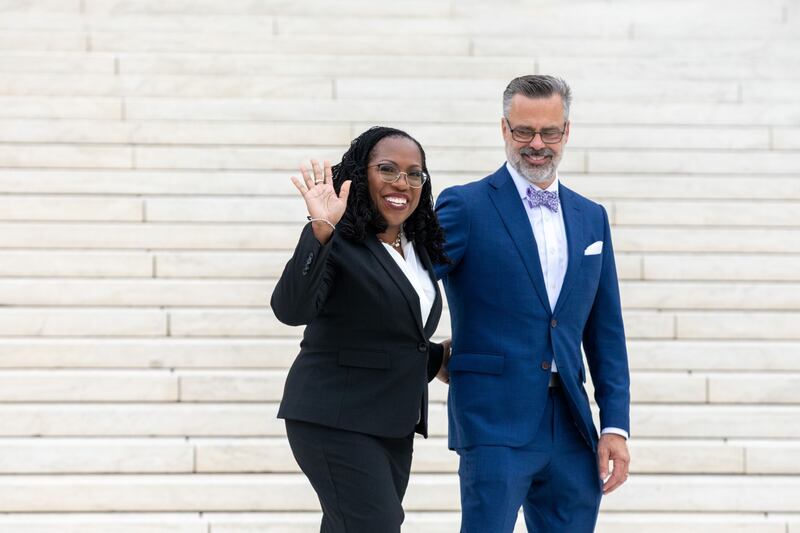Last June the US supreme court reshaped decades of social policy in the country with a landmark ruling to end a federal constitutional right to an abortion.
The move arguably changed the trajectory of American politics, galvanising a revival in the fortunes of the Democratic Party which up to then had seen set for a drubbing in midterm elections in November.
The abortion ruling as well as a series of other decisions handed down such as on gun control and climate also led to claims that the court had firmly moved to the right on foot of the appointment of three conservative judges by Donald Trump when he was in the White House.
The rulings have had an impact on how the court is judged by the American public.
RM Block
A Gallup poll this week found that approval of the court stood at 43 per cent. A total of 42 per cent said the court was “too conservative” compared with 38 per cent who considered it to be “about right”.
Justice Samuel Alito, the judge who wrote the controversial abortion ruling, indicated to the Wall Street Journal this week that he thought criticism of the court was going too far.
“It goes without saying that everyone is free to express disagreement with our decisions and to criticise our reasoning as they see fit. But saying or implying that the court is becoming an illegitimate institution or questioning our integrity crosses an important line.”
Alito’s comments were viewed in some parts of the US media as the latest in a series by the country’s top judges over the summer in which they appeared to spar publicly about the questions over the court’s legitimacy.
On Monday morning, the nine justices of the supreme court will be back at work, hearing cases as part of a new law term.
The cases could potentially have significant implications in crucial areas such as voting arrangements, LGBT rights, immigration and affirmative action in third-level education.
However, even aside from the contentious issues on which it will have to rule, the Supreme Court is also facing controversies outside of its chambers.
Internal investigation
An internal investigation has been rumbling along into how a draft of the abortion ruling was leaked in May. US chief justice John Roberts said at the time the unprecedented disclosure of the draft ruling was “a betrayal”. In the near future, the court authorities will have to reveal the outcome of this inquiry and whether anyone has been identified as being responsible for the leak.
At the same time, the court is facing calls for one of its members, Justice Clarence Thomas to step aside from any cases relating to matters linked to the presidential election amid reports that his wife, Ginni Thomas, urged Republican politicians to overturn the victory of Joe Biden in 2020.
Ms Thomas on Thursday gave evidence in private before the congressional committee investigating the events behind the riots at the US Capitol on January 6th last year and the attempt to delay the certification of Biden’s victory in the 2020 election.
The new term will also see a new justice on the bench.
Justice Ketanji Brown Jackson, the first black woman to ever sit on the court, was appointed by Biden earlier this year.

It is anticipated that Jackson will join the liberal minority on the court which will still be dominated by conservative judges.
A key case the justices will hear could, liberals fear, lead to state courts losing power to oversee federal elections.
In February, the supreme court in North Carolina struck down a proposed election map of congressional constituencies on the grounds that it represented “egregious and intentional partisan gerrymandering” in favour of Republicans and violated the state constitution. Republicans subsequently appealed to the supreme court in Washington.
They have raised a controversial legal theory – known as “independent state legislature” theory – which contends that only the state legislature can regulate federal elections, not state court. Critics fear that if this is upheld by the supreme court, it would give Republican-controlled legislatures in some states greater powers over federal elections free of oversight from local courts.
The supreme court will also hear a potential landmark case on LGBT rights.
Wedding websites
It centres on a graphic designer in Colorado who is seeking to expand her business to include wedding websites. However, she does not want to design wedding websites for same-sex couples on religious grounds, and wants to highlight this restriction to clients.
But Colorado law forbids businesses from discriminating on the basis of sexual orientation or announcing an intention to do so.
The court will have to adjudicate on whether this violates the right to free speech under the US constitution or whether there should be an exception on religious grounds from the application of anti-discrimination legislation.
The supreme court is also to hear cases which could have implications for the future of affirmative action – efforts to improve opportunities for ethnic minority groups in the third-level education sector.
In one case against Harvard University, a group known as “Students for Fair Admission” contends the college’s admissions policy discriminates against Asian-American applicants. The group argues that Asian Americans are significantly less likely to be admitted than similarly qualified Hispanic, black or white students. Harvard maintains that it does not discriminate against Asian-American applicants. It claims the plaintiffs are citing misleading statistics, and contends that race-conscious admission policies are legal.
In a second case, Students for Fair Admissions argues that the University of North Carolina discriminates against white and Asian students by awarding preferences to black, Hispanic and native Americans as they are considered as underrepresented minorities. The university maintains its policies are lawful and aimed at building a diverse campus.
If the court strikes down the admission policies in either universities, it would overturn years of precedent in previous rulings.



















